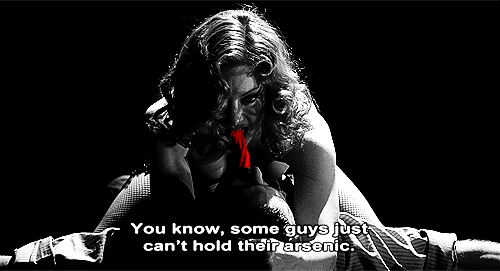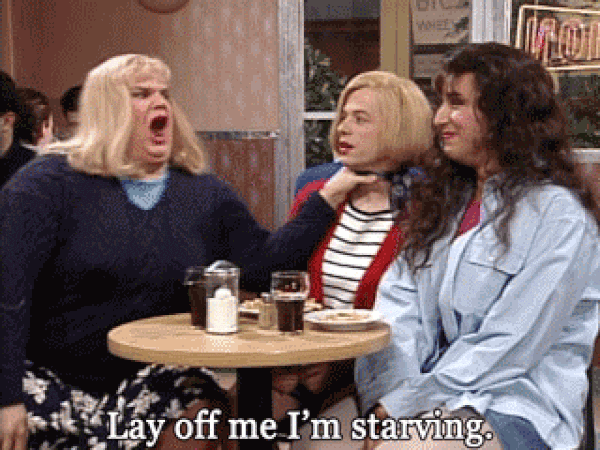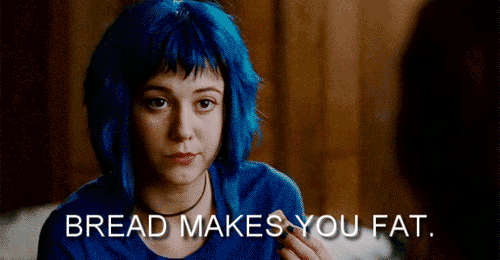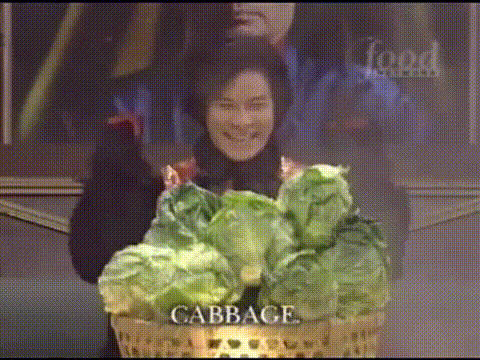In a lot of ways, we should consider ourselves lucky that many of us are trying to watch our weight. For the majority of human history, getting enough to eat has been more of an issue. In fact, it wasn’t until the early 19th century that the ideal figure evolved to something noticeably more svelte.
And thus, we have been dieting ever since. But were these diets ever really effective? From slimming potions to green juices, here are a few highlights of some of the most interesting diet trends over the past 200 years, told in that oh-so-modern of ways: through GIF’s.
THE 1800s: FOOD WITH PURPOSE

Before it became integral to America’s favorite campfire treat, the graham cracker was one of the first diet foods. Created by a New Jersey minister — the not-so-coincidentally named Rev. Sylvester Graham — these yummy snacks were made with whole-grain flour instead of the refined white flour that was popular at the time. Graham created a heartier, nutritious biscuit with unsifted flour and no additives, which he believed to be far superior to white bread. He wasn’t wrong. But sorry, campers: That still doesn’t make s’mores a health food.
MAGICAL PILLS AND POTIONS

In the 1800s, pills, tonics and potions containing arsenic became increasingly popular due to the claim that they cleared the complexion and helped boost the metabolism. Though the amount of arsenic used was small, people tended to take more than the recommended dosage so it would work faster. Side effects included hair loss, stomach pains, vomiting, diarrhea and that irreversible condition known as death.
CELEBRITY DIET 101: LORD BYRON

Long before Khloé Kardashian started publishing her workouts on Snapchat, the famed poet Lord Byron also worked hard to maintain his physique: pale and thin, considered “fashionable” during the early 19th century. He claimed he had a “morbid propensity to fatten,” according to “Calories & Corsets” by Louise Foxcroft. Absolutely terrified of being fat, Byron weighed himself regularly and began to starve himself, sticking to foods like biscuits and soda water, potatoes drenched with vinegar or simply a bit of claret instead of food. He was so culturally influential that he was accused of encouraging young people to not only worry about weight but also to follow his strange diet patterns — including drinking vinegar to drop pounds.
LOW CARBS WAY AHEAD OF THEIR TIME

In the 1860s, a London carpenter named William Banting suffered from poor eyesight and hearing, knee problems and other health issues he believed stemmed from his weight. His diet strategy focused on consuming vegetables and meat, while avoiding bread, pastry and potatoes. He managed to see results within just a few days, eventually losing 50 pounds and vastly improving his health. He then published his regimen in a book titled “A Letter on Corpulence,” and, for many years after, “dieting” also was known as “banting” in England and the U.S.
THE EARLY 1900s: CHEW IT AGAIN, SAM

At the turn of the 20th century, American entrepreneur Horace Fletcher advocated chewing each mouthful of food a minimum of 100 times per minute, in the hopes of extracting every bit of nutrition from it, before swallowing. This became known as “Fletcherism,” and he earned the nickname “the Great Masticator.” That must explain all those fantastic jawbones in early silent movies.
THE 1920s-50s: A SLEW OF LOW-CALORIE TRENDS

In 1925, advertisements for Lucky Strike cigarettes sported the slogan “Reach for a Lucky instead of a sweet” to discourage people from consuming too many calories. Thanks to the appetite-suppressing power of nicotine, smoking became all the rage among those who wanted to watch their figures. MyFitnessPal endorses pretty much nothing in this paragraph.

In the 1930s, the Grapefruit Diet (also known as “the Hollywood Diet”) called for eating half a grapefruit before every meal. The fruit’s fiber and liquid helped to fill you up, and you’d eat less, lowering your calorie intake. The downside? Grapefruit with every meal got uber boring, and many dieters had a hard time sticking to it.

In the 1950s, the Cabbage Soup Diet promised people could lose up to 15 pounds in a week by eating cabbage soup every day — similar to the Grapefruit Diet, fiber and liquid played a part in preventing you from eating too much. This still remains a popular diet fad today — although you’re probably more likely to clear a room than lose weight.
THE 1960s-70s: COOKIES, SHAKES AND QUICK-FIX PILLS

Beginning in the ’60s, pills began emerging as a favorite diet tool — the “Sleeping Beauty Diet” advocated sleeping up to 20 hours a day to avoid eating, thanks to the use of sedatives. (Elvis Presley was supposedly a fan.) In the ’70s, Dr. Sanford Siegel introduced the Cookie Diet to Hollywood, where six cookies containing a special blend of amino acids would make up your day’s calorie intake. The SlimFast diet helped its followers create a calorie deficit by replacing breakfast and lunch with their shakes. By the end of the decade, shelves began to fill with Dexatrim, a diet pill made with phenylpropanolamine (which eventually was linked to an increased stroke risk, resulting in a formula change 20 years later).
THE 1980s: LET’S GET PHYSICAL

The awesome ’80s saw an uptick in aerobic exercise, thanks to videos from Jane Fonda and Richard Simmons, and the opening of Jazzercise studios in all 50 states. The diet trends of the prior decade carried over, and the ’80s also saw a surge in the popularity of low-fat and cholesterol-free foods like margarine and fat-free cookies. Studies later questioned the validity of the fat-free ideology — America saw a rise in obesity and diabetes toward the end of the decade and into the early 1990s. Totally bogus.
THE 1990s: GOING LOW-CARB CRAZY

Dr. Robert C. Atkins created his eponymous diet in the early ’70s, but it didn’t go viral (in a pre-viral world) until he published an updated version of it in his 1992 book, “Dr. Atkins’ Diet Revolution.” The Atkins Diet was one of the modern proponents of a high-protein approach and sparked the “low-carb” fad, along with the South Beach Diet and Zone Diet. When “Friends” star Jennifer Aniston showed off a more svelte physique in the late ’90s, it was largely attributed to the Zone Diet. (Kitchen obsessive-compulsiveness, meanwhile, is still largely attributed to Monica Geller.)
THE 2000s: GWYNETH AND BEYONCÉ MADE ME DO IT

Celebrity-endorsed diets really took center stage in the new millennium, with Gwyneth Paltrow accrediting her slim figure to the high-fiber, low-fat Macrobiotic Diet: carefully designed meals of whole grains, vegetables, beans and sea vegetables. In 2004, Mireille Guiliano, then CEO of the Champagne house Veuve Clicquot, published the book “French Women Don’t Get Fat,” giving hope to women everywhere that they could be thin while still enjoying cheese and wine. (There is a God!) In 2006, Beyoncé Knowles admitted to using the Master Cleanse — a diet comprising solely of a drink made of hot water, lemon juice, maple syrup and cayenne pepper — to aid her in losing 20 pounds for her role in the movie “Dreamgirls.” And in 2009, the Kardashians endorsed QuickTrim, a diet pill that claimed to boost weight loss.
TODAY: #EATCLEAN

Finally, we’ve arrived at our current diet landscape. There are still a handful of questionable trends on the market — like the controversial HCG diet, which uses a fertility drug and extreme calorie restriction, or juicing popularized by the movie “Fat, Sick and Nearly Dead,” which documented Joe Cross’ own 60-day juice fast and subsequent weight loss.
Thankfully, many of today’s diets for weight loss are more lifestyle changes that are geared toward overall health, clean eating and well-rounded nutrition. Kale became the poster vegetable for anyone who wanted to eat healthier. Raw foods have become increasingly popular as they are unprocessed and uncooked. Gluten-free and vegan diets have proliferated. And the CrossFit crowd popularized the Paleolithic, or “Paleo,” diet, emphasizing eating natural, noncultivated foods: meat, nuts, eggs, vegetables, fish and fruits — but no grains, dairy or refined sugar.
So what have we learned through all this? Dieting trends will come and go, but there is no single formula for losing weight that will work for everyone. Regular exercise and nutrition play key roles in our overall health — not just our waistlines — so it’s a great idea to do a little bit of research to find out whether that new diet is just hype.
Need help figuring out where to start? Check out this article on How to Eat Like a Successful MyFitnessPal User.




